Cemeteries offer excellent wildlife viewing opportunities, especially for birds at dawn and dusk. Visit during spring for migratory species or fall for foliage-drawn wildlife. Look for water features like ponds or streams that attract diverse species. Most locations provide accessible parking near entrances with paved paths. Remember to maintain quiet respect while photographing, and check for permission requirements beforehand. The hidden wildlife corridors between cemetery sections hold some of nature’s most rewarding surprises.
Cemetery Visitor’s Guide: Wildlife Spots and Parking
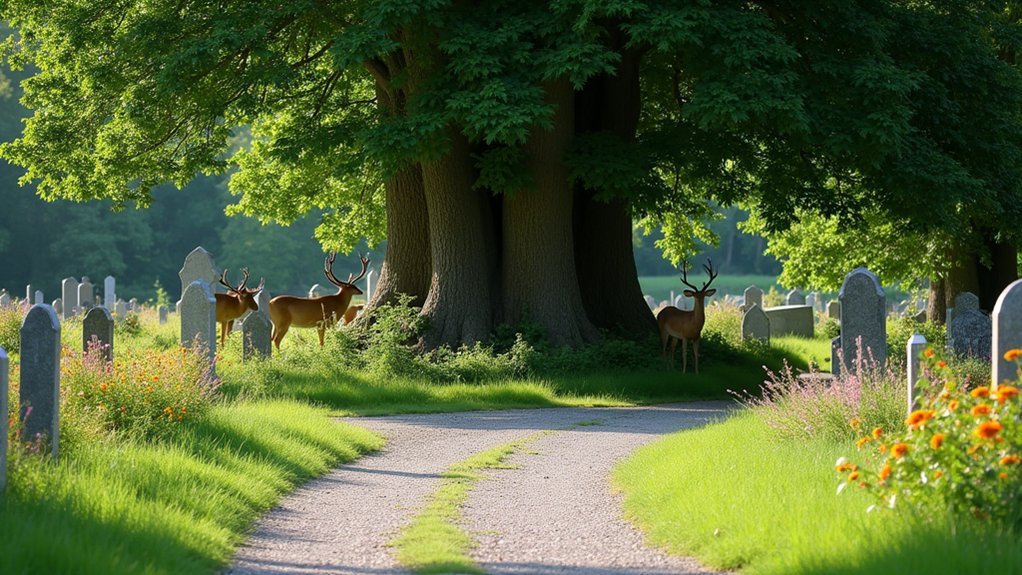
While cemeteries serve as final resting places, they also offer surprisingly rich habitats for local wildlife and peaceful natural settings. Many cemeteries, like Houston’s Glenwood Cemetery, function as unofficial nature preserves where you’ll spot diverse bird species and other wildlife among serene landscapes.
When planning your visit, you’ll find parking typically available near cemetery entrances, providing convenient access to walking paths and wildlife viewing areas.
Stop by the cemetery office for visitor’s guide maps highlighting notable wildlife spots and historical markers throughout the grounds.
As you explore, look for designated areas with benches where you can rest while observing local fauna and flora.
Your quiet walks through these tranquil spaces will reward you with both wildlife sightings and moments of peaceful reflection.
Best Times for Bird Watching in Historic Cemeteries
Three ideal times exist for cemetery bird watching enthusiasts. Early morning and late afternoon offer prime viewing as birds actively feed during cooler hours.
Spring and early fall present exceptional opportunities to spot migratory species passing through historic cemeteries on their seasonal journeys.
As songbirds follow ancient passages, cemeteries become ephemeral hotels during spring’s rebirth and autumn’s gentle decline.
Weather conditions matter too—overcast days often encourage birds to forage more visibly without harsh sunlight.
For the best experience, seek out sections with diverse vegetation; areas with mature trees, flowering shrubs, and native plants attract the widest variety of birds.
Remember to maintain a quiet demeanor during your visit. Move slowly, speak softly, and bring binoculars to observe without disturbing these feathered visitors.
Historic cemeteries provide perfect sanctuaries for birds—and for those who appreciate them.
Accessible Parking Options at Popular Cemetery Birding Sites
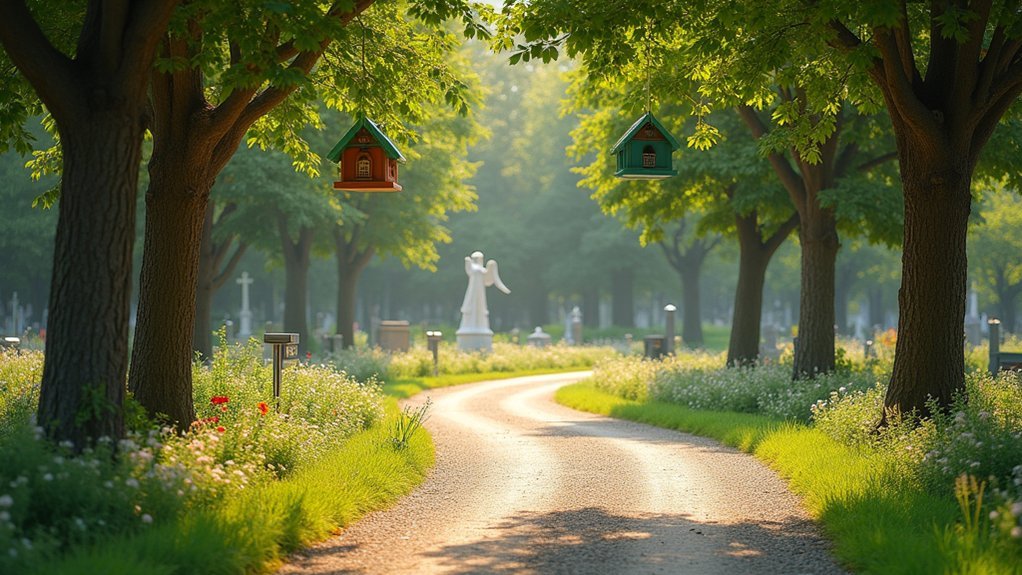
For birders with mobility considerations, most popular cemetery birding locations provide accessible parking solutions that enhance the overall experience.
Sites like Glenwood Cemetery in Houston feature designated spaces near the entrance, ensuring you’ll spend more time watching birds and less time maneuvering to wildlife spots.
Before visiting, check the cemetery’s website or call their office to confirm parking availability.
Many locations, including Salt Lake City Cemetery, offer paved paths connecting parking areas directly to prime bird watching locations.
You’ll typically find accessible parking near visitor centers, where you can also collect maps highlighting notable cemetery birding areas.
Larger cemeteries maintain ample parking lots accommodating various vehicles with special needs, making these peaceful sanctuaries welcoming to all bird watchers regardless of mobility challenges.
Seasonal Wildlife Variations in Urban Memorial Parks
As seasons change, urban memorial parks transform into dynamic wildlife sanctuaries that offer visitors remarkable biodiversity throughout the year.
In spring, you’ll spot migratory birds returning to these peaceful havens, making cemeteries prime birdwatching locations during morning hours when avian activity peaks.
Summer brings butterflies to blooming flowers, while water features become essential for wildlife seeking relief from heat.
Summer transforms memorial gardens into vibrant sanctuaries where butterflies dance among flowers and creatures gather at cooling waters.
Look for small mammals near ponds, especially at dusk when they’re most active.
Fall’s vibrant foliage attracts diverse species preparing for winter, with increased wildlife movement throughout these urban nature pockets.
During cooler months, you’ll find deer and foxes more visible, particularly in areas with minimal foot traffic.
For the best wildlife viewing, visit during early mornings or late afternoons when cemetery residents are most active.
Etiquette for Nature Photography in Cemetery Grounds
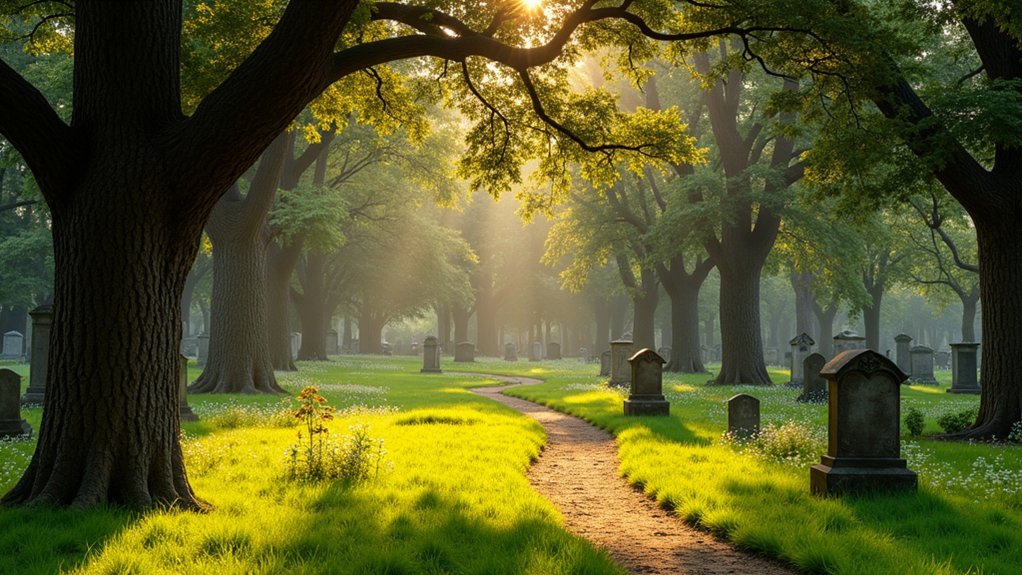
While cemeteries provide stunning natural backdrops for photography, they’re primarily places of remembrance that require special consideration from visitors with cameras.
Always obtain permission before photographing specific graves or memorials, respecting both families and cemetery policies.
As you capture wildlife and landscapes, watch your step to avoid disturbing graves or memorial flowers. Your photography etiquette should include maintaining a quiet presence—wildlife responds better to stillness, and other visitors deserve their peaceful moments undisturbed.
Consider visiting during less busy hours when you’ll have clearer shots without interfering with mourners.
Before your visit, check if the cemetery has photography guidelines or requires permits for professional equipment. Proper respect guarantees these serene spaces remain welcoming to both photographers and those seeking solace.
Notable Tree Species That Attract Diverse Bird Populations
Cemeteries often serve as unexpected sanctuaries for avian wildlife because of their diverse tree populations that have matured undisturbed for decades.
You’ll find majestic oak trees providing abundant acorns that attract woodpeckers and jays throughout the seasons. Cedar trees create perfect roosting spots for mourning doves and sparrows seeking shelter or nesting sites.
Look for pine trees, particularly Eastern white pine and loblolly varieties, which support chickadees and nuthatches with their nutritious seeds.
During spring, flowering trees like magnolias and dogwoods transform cemeteries into pollinator havens, drawing hummingbirds and colorful warblers.
The mature hardwoods establish complex habitats rich in insects—a natural buffet for thrushes and flycatchers.
These established trees make cemeteries valuable wildlife corridors in otherwise developed areas.
Navigating Cemetery Pathways With Birding Equipment
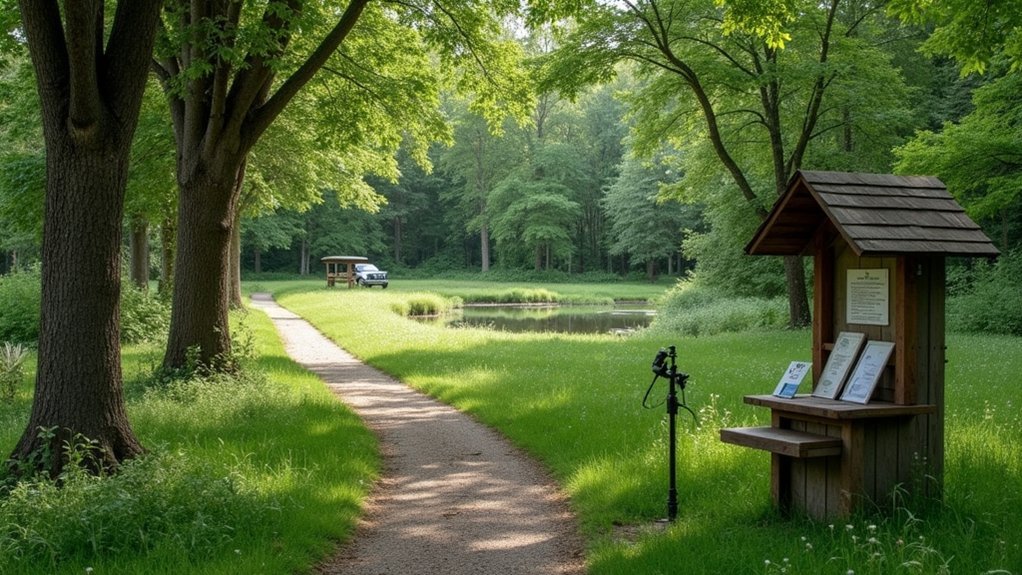
Beyond the serene atmosphere, Glenwood Cemetery offers perfect terrain for birdwatching enthusiasts of all experience levels.
When exploring the cemetery’s winding pathways, you’ll need appropriate gear to make the most of your wildlife observation experience.
To successfully navigate while birdwatching at Glenwood Cemetery:
- Wear comfortable footwear that can handle extended walking, as the cemetery’s pathways stretch throughout the grounds, providing access to diverse bird habitats.
- Carry binoculars in a secure neck strap or harness that allows quick access without hindering your movement between observation points.
- Keep your field guide or smartphone app readily accessible—perhaps in a small backpack or crossbody bag—so you can identify species without fumbling through equipment.
Visit during early morning or late afternoon for ideal wildlife viewing conditions.
Quiet Observation Areas With Convenient Access Points
Glenwood Cemetery offers five strategically placed observation areas where you’ll find the ideal balance of solitude and wildlife activity. These quiet observation areas feature comfortable benches nestled among ancient oaks, providing nature enthusiasts with convenient access to the cemetery’s diverse avian species. You’ll appreciate the serene atmosphere created by rolling hills that naturally buffer city noise.
| Location | Features | Best For |
|---|---|---|
| Skyline Point | Houston skyline view | Dawn/dusk photography |
| Oak Grove | Dense tree canopy | Woodland birds |
| Memorial Plaza | Multiple benches | Group birdwatching |
For best wildlife spotting, pick up a detailed map from the office highlighting these hotspots. The extensive pathway network guarantees you’re never far from reaching these tranquil observation points, even when carrying birding equipment.
Water Features That Draw Migratory Species Year-Round
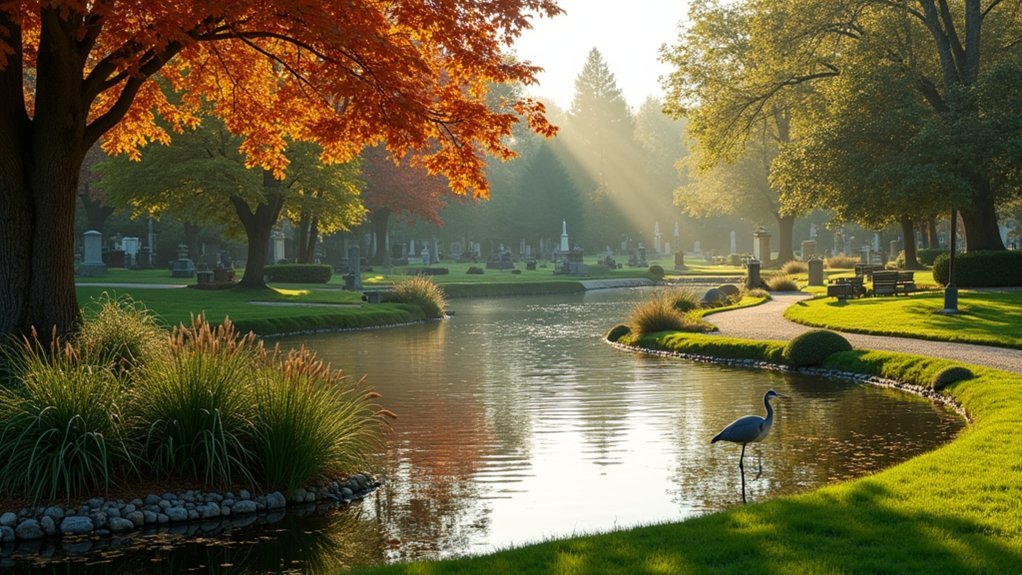
Throughout the seasons, Glenwood’s network of serene water features serves as a critical haven for migratory birds seeking respite during their long journeys.
Sanctuary waters nestled among memorial grounds provide vital rest stops for nature’s weary travelers.
You’ll find these tranquil settings particularly active during spring and fall migrations, when diverse species rely on our ponds and streams as essential habitats.
The cemetery’s commitment to biodiversity is evident in these carefully maintained aquatic environments:
- East Pond – Home to herons and shorebirds, with viewing benches positioned for prime wildlife observation
- Willow Stream – Attracts various duck species and supports rich insect life that feeds migratory visitors
- Memorial Fountain Area – Features native aquatic plants that provide shelter and nourishment for smaller bird species
These water features offer you a peaceful opportunity to witness nature’s travelers while enjoying the cemetery’s contemplative atmosphere.
Recommended Field Guides Specific to Cemetery Ecosystems
To fully appreciate the feathered visitors that frequent our water features, you’ll want a reliable field guide in hand during your cemetery explorations. Cemetery ecosystems in Texas, particularly Glenwood Cemetery, host diverse avifauna deserving your attention.
| Guide Title | Best For | Special Features |
|---|---|---|
| Sibley Guide to Birds | All skill levels | Detailed illustrations with multiple plumages |
| Audubon Society Field Guide | Understanding behavior | Extensive habitat information |
| Birds of Texas | Local wildlife | Species-specific to Texas cemeteries |
Birdwatchers visiting cemetery grounds benefit from guides that address both natural and historical elements. Regional-specific resources like “Birds of Texas” help you connect meaningfully with local wildlife, while extensive guides enhance your overall experience by encouraging exploration beyond headstones to the vibrant ecosystem that thrives within cemetery boundaries.
Vehicle Considerations for Different Cemetery Terrains
Selecting an appropriate vehicle can considerably enhance your cemetery wildlife observation experience. Most well-maintained cemeteries with paved paths accommodate standard vehicles, while those with uneven terrain may require higher clearance to protect your car’s undercarriage.
Before visiting, consider:
Before embarking on your cemetery wildlife expedition, thoughtful preparation ensures both respect for the grounds and optimal observation conditions.
- Terrain assessment – Paved roads allow any vehicle, while gravel or dirt paths might necessitate SUVs or trucks.
- Parking options – Look for designated visitor parking areas near entrances, which often provide convenient access to wildlife-rich zones.
- Alternative arrangements – For limited parking cemeteries, be prepared to park elsewhere and walk in comfortable footwear.
Always respect cemetery parking regulations, which exist to maintain accessibility for all visitors while protecting these peaceful environments and their diverse ecosystems.
Hidden Wildlife Corridors Between Adjacent Cemetery Sections
While many visitors focus on the monuments and landscaped areas, cemeteries often harbor remarkable hidden wildlife corridors that connect adjacent sections.
At Glenwood Cemetery, these natural pathways allow birds and small mammals to move undisturbed throughout the grounds.
As you explore the cemetery, you’ll notice mature oak trees and lush vegetation creating ideal habitats for diverse bird species.
These corridors aren’t just beneficial for wildlife—they enhance your experience too. The secluded areas where you’re likely to spot squirrels and rabbits contribute to the tranquil setting, perfect for peaceful reflection.
For the best birdwatching opportunities, seek out these hidden wildlife corridors between sections.
They often serve as feeding and nesting sites, offering glimpses of local fauna against the backdrop of this serene landscape.
Frequently Asked Questions
Are Pets Allowed During Wildlife Viewing Excursions?
Pets aren’t allowed during wildlife viewing excursions. You’ll need to leave your furry friends at home to avoid disturbing the natural habitat and wildlife behavior. This guarantees everyone enjoys ideal viewing experiences.
Can Drones Be Used for Aerial Cemetery Wildlife Photography?
No, you can’t use drones for cemetery wildlife photography. They disturb both wildlife and mourners. The noise disrupts peaceful reflection and might frighten animals. Please stick to ground-level photography during your visit.
Do Cemeteries Offer Guided Wildlife Tours?
Some cemeteries do offer guided wildlife tours. You’ll find these tours highlight local fauna and flora while respecting the cemetery’s primary purpose. Check with specific locations, as availability and scheduling vary widely.
Are Nighttime Wildlife Observation Sessions Permitted?
Nighttime wildlife observation isn’t typically permitted in cemeteries. Most close at sunset for security reasons. You’ll need to check with specific cemetery management for any exceptions to their standard visiting hours.
How Do Cemetery Maintenance Practices Affect Local Wildlife Populations?
You’ll notice our low-impact maintenance practices benefit wildlife populations. We’ve reduced mowing frequency, eliminated pesticides, and preserve deadwood habitats. These changes have increased bird, small mammal, and pollinator diversity throughout the grounds.
In Summary
You’ll find cemetery visits can be rewarding beyond paying respects to loved ones. Whether you’re spotting a red-tailed hawk perched on an ancient monument or quietly observing deer at dawn, these peaceful sanctuaries offer unique wildlife encounters. Remember to park considerately, follow posted guidelines, and always maintain reverence for the space. Your camera, binoculars, and field guide will serve you well in these unexpected havens of biodiversity.





Leave a Reply